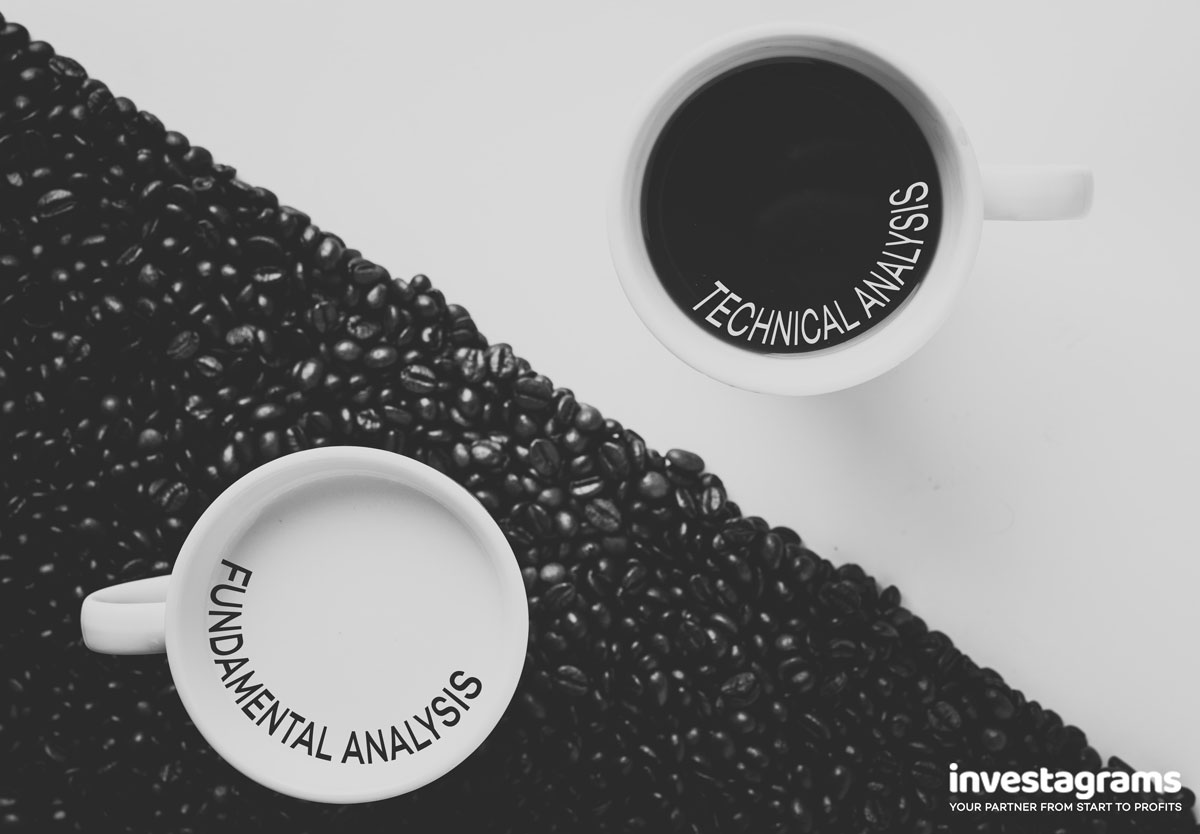In general, there are two sides when it comes to stock market analysis—fundamental analysis and technical analysis. Today we’ll discuss both methods and explain their advantages and disadvantages.
**Before we begin, you may want to check out these basic terms to help you understand this article better.
What are fundamental analysis and technical analysis?
Fundamental analysis a method of stock market analysis where investors study the intrinsic value of a stock (A.K.A. what it should cost) based on a variety of factors. Decisions on whether to buy, sell, or hold a stock are based on comparing the intrinsic value to the market price. Fundamental analysis is generally less structured than technical analysis and is used most by long-term investors.
Technical analysis, on the other hand, is easier to apply to short-term stock trading. This method uses historical data on price, volume, and other statistics to predict future price movements. Stock charts are commonly used in technical analysis to track and analyze patterns that can predict price movement.
In reality, most traders will use a combination of these two methods. A general rule of thumb is that fundamental analysis will help you determine which companies to invest in, while technical analysis will help you determine when you should buy and sell shares of these companies.
So how do each of these methods work? Let’s take a deeper look.
How does fundamental analysis work?
In fundamental analysis, our objective is to assess the company’s performance and stability—basically whether it is a good business or not. This includes looking at financial statements, its performance compared to others in the same industry, news that may affect the company’s operations, and more.
When looking at the financial statements, one of the most important indicators is the company’s net income. We’re not talking about NGO’s or charities after all. In the stock market, a company needs to be making money to be valuable. However, you should remember that a company’s income only shows one part of the picture.
Using a combination of financial statements and news, you can answer more complex questions such as: Are the company’s expenses high compared to the industry average? What amount of its earnings are retained and reinvested into the company? Are they constantly improving their product or service? What are their plans for the future and will these plans increase or decrease their value? What risks are they taking are you willing to take on the same risk?
There is no single way to do fundamental analysis, but at the end of the day there is one question every fundamentalist is trying to answer: Is this a business that I want to put my money into?
How does technical analysis work?
In technical analysis, people focus more on identifying trends and chart patterns rather than the company’s intrinsic value. The underlying idea here is that a stock’s market value is not always determined by its intrinsic value. Especially in the short term, a stock’s price is mostly influenced by external factors such as market sentiment. Patterns and trends can be identified based on historical data, and this is what allows us to predict how sellers and buyers (read: supply and demand) will react.
There is a long list of tried and tested techniques for performing technical analysis, but there are far too many for us to cover in one article. Some of the most basic methods include:
- Identifying chart patterns such as the cup and handles, head and shoulders, ascending triangle, etc.
- Assessing the market sentiment based on price movement, volume, moving averages, etc.
- Identifying and riding trends until your preferred indicators signal otherwise
Whatever your preferred methods for technical analysis, the objective remains the same: To capitalize on patterns formed by the unified emotions and reactions of market players.
So which is better, fundamental analysis or technical analysis?
While everyone has their own preferences, neither method is really better than the other. That’s why they both exist! Each method of analysis has strengths and weaknesses. It’s just a matter of finding your own fit.
If you want to invest long-term, then you might want to go for a more fundamental approach. You’ll have to do more work initially, but you won’t be as sensitive to the day-to-day price fluctuations. If you are able to buy an undervalued stock, all those ups and downs will still result in an overall price increase and profit for you.
If you’re going for a short-term investment, then technical analysis might be a better option. Because prices tend to fluctuate, patterns in price movement will more accurately predict the stock price tomorrow or next week. The emotions and reactions of market players have a bigger impact on short-term investments because there isn’t enough time for the ups and downs to average out—unlike in long-term investments.
In reality, most traders use a mix of fundamental and technical analysis to manage their portfolios. This allows them to see the complete picture and make more informed trades. Information, after all, is power. Nowhere is that statement more true than it is in the stock market.
Our advice?
The more knowledge you have, the better. Learning both fundamental and technical analysis will not only help you make better decisions, but also give you more confidence in yourself and your trades. This will prevent you from giving into hyped up stocks or selling your stocks too early because you doubted yourself. It will also allow you to start building your own stock trading system and strategy—the foundation of any trader trying to make money in the stock market.
Even if you eventually become a pure fundamental or technical trader, you won’t know which method works best for you if you don’t try them both first! You may even use one method to validate your analysis using the other. So give both methods a try, and tell us about your experience in the comments below.
Got any questions? Leave a comment below!
Subscribe to InvestaDaily for more articles like these, or sign up for Investagrams to access special features to help you reach your first million.



